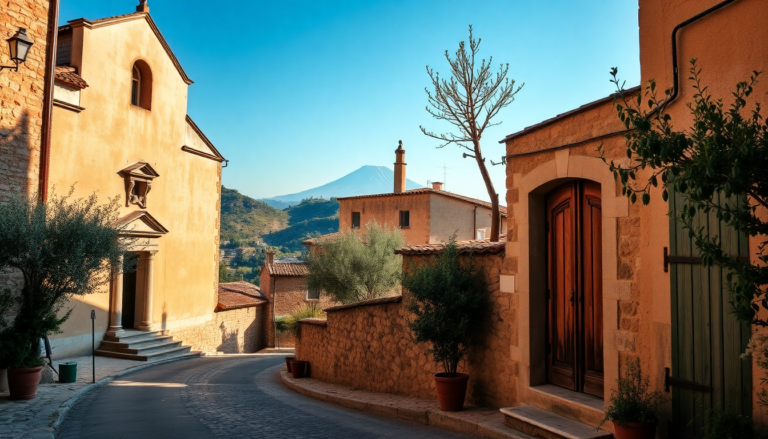Argomenti trattati
Savoca is a picturesque village nestled in the hills of Sicily, known for its rich history, cinematic heritage, and spiritual ambiance. With its cobblestone streets and rustic charm, this small village offers a unique blend of attractions that transport visitors to a timeless realm. From its ancient churches to breathtaking views of Mount Etna, Savoca is a place where the past and present coexist beautifully.
Historical significance of Savoca
Located in the province of Messina, Savoca is set in the scenic Agrò Valley, approximately 40 kilometers from Messina and 20 from Taormina. The village, home to around 1,750 residents, captures the essence of small-town life, where the rhythm of the seasons influences daily activities. Upon entering the village, one is greeted by the Porta della Città, a remarkable remnant of the Norman fortifications that once protected Savoca. This monumental sandstone arch, dating back to the 12th century, is a testament to the village’s storied past, accessible through two main entrances: one in the San Giovanni district and another in San Michele. Today, only the latter remains, silently bearing witness to an era of conquests and legends.
Exploring ancient ruins
On one of the hills overlooking the village lies the enigmatic ruins of the Pentefur Castle, its origins shrouded in mystery. Possibly dating back to the late Roman or Byzantine period, the castle was reconstructed in the 12th century under the reign of Roger II of Sicily to serve as a summer residence for the Archimandrite of Messina. Today, only remnants remain: a quadrangular keep and fragments of crenellated walls. From this elevated position, visitors can appreciate the castle’s strategic purpose, once part of a defense system connected to coastal towers like Torre Catalmo and Torre dei Saraceni.
Architectural treasures
The Church of San Michele, built around 1250, stands as one of Savoca’s most significant monuments. Declared a national monument in 2002, it has transformed through the centuries. Originally a place of worship in the Greek rite, it was expanded in the 1400s with two Gothic-Siculo-Chiaramontano portals, enhancing its simple façade. Inside, the church houses remarkable artistic treasures, including a fresco from 1701 depicting the Baptism of Christ, ancient paintings of Saints Cosmas and Damian, baroque altars, and even the tombs of local notables.
The iconic Church of San Nicolò
Perched on a steep cliff, the Church of San Nicolò is emblematic of Savoca, famous for its association with a pivotal scene from the film ‘The Godfather.’ It was here that Michael Corleone emerged alongside Apollonia on their wedding day. This church, established in the 13th century, showcases a blend of Byzantine frescoes and a solid architectural structure that resembles a fortress. Adorned with a notable 15th-century marble bust of Saint Lucia and a bell tower, the church’s interior boasts three elegant naves separated by granite columns and rich altars, preserving a collection of art salvaged from collapsed churches in the area.
Cultural heritage and cinematic connections
In the heart of the village lies Palazzo Trimarchi, an elegant noble residence built between the late 17th and early 18th centuries. Its ornate stone balconies add to the building’s charm, but it is best known globally for its cinematic history. In 1971, key scenes from ‘The Godfather’ were filmed on its ground floor, where Michael Corleone asks for Apollonia’s hand in marriage. Today, the local bar, known as Bar Vitelli, remains a nostalgic spot, adorned with memorabilia and photographs celebrating the village’s connection to the film.
The Church of Calvary and its surroundings
High above the village, the Convent of the Capuchins, constructed between 1603 and 1614, retains its original structure. The convent once featured a library, refectory, and kitchen, while the upper floor housed the friars’ cells. Notably, the Capuchins maintained a self-sufficient lifestyle thanks to a large garden, now a public park. The crypt beneath the church reveals a haunting yet fascinating aspect of Savoca’s past, containing the mummified bodies of local aristocrats and bourgeoisie, preserved in open coffins and dressed in period attire.
Natural beauty and local traditions
Visitors to Savoca can also explore the breathtaking landscape surrounding the village. The Church of Calvary, dedicated to the Blessed Virgin of the Seven Sorrows, stands atop a hill overlooking the area, offering striking views of Mount Etna and the Ionian coast. Built in the 18th century, the church was erected on the remains of a former hermitage. It has become a focal point for rituals connected to Holy Week, celebrated with solemnity and community involvement.
As you wander through Savoca, the blend of history, cinema, and spirituality creates an enchanting atmosphere. It invites contemplation and a deeper appreciation for the enduring legacy of this remarkable village.

